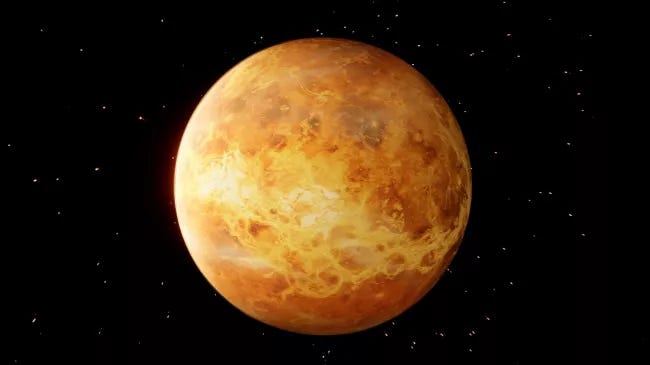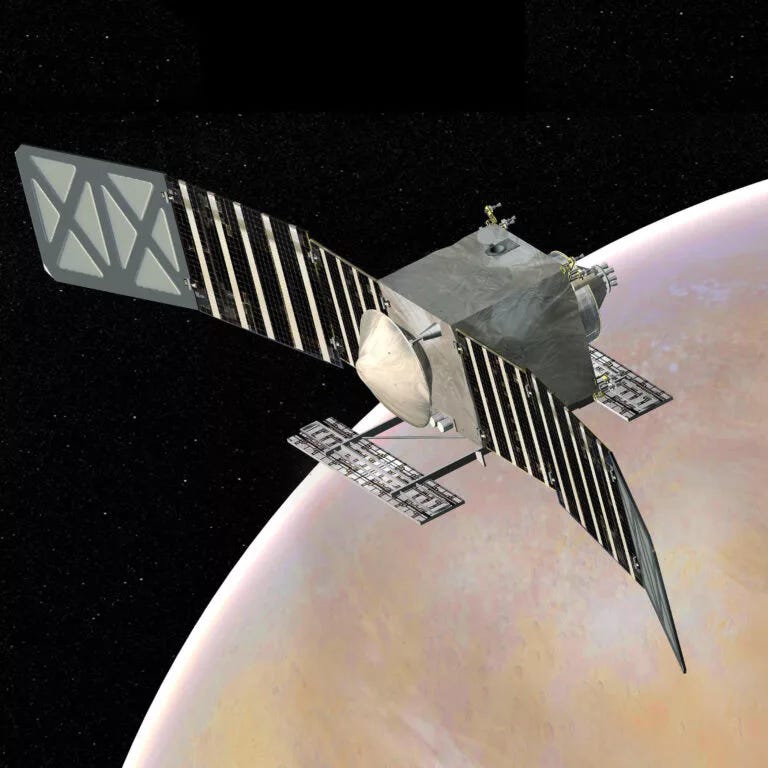Venus, a world of some of the most extreme conditions in the universe is a neighbour planet of Earth. A planet spinning from west to east have atmosphere full of greenhouse gases such as carbon dioxide, methane, ozone, etc… that causes greenhouse effect on planet in large proportion.
The sky of Venus is always filled with the thick clouds that pours down showers of warm sulphuric acid on the planet's surface. The clouds of Venus absorb around 75% of sunlight reaching to the planet that heats up the atmosphere & also the active volcanoes do not produce less heat. The resultant heat produced from the planet's activities climbs the surface temperature of Planet to 500°C, enough to melt lead. The pressure on the surface is also not less than 90 bars that had crushed the Russian landers in an hour.
The hostile Venus & calm Earth are popularly known as 'twin planets' of our Solar System due to their similarities in size, mass, geologic structures & features, initial atmospheric conditions & much more. The size of the planet is slightly smaller than Earth & possess mass of around 80% to that of Earth.
Venus too have large metallic iron core with molten rocky mantle of around 3000km below its 10-20km thick basalt. Around two-third of the surface is covered with flat plains along with volcanoes & lava flows similar to Earth. The surface is totally dry along with some ridges & valleys known as 'tesserae' formed by raised regions in different directions.
A biggest reason for these two planets to be twin is their initial geologic conditions. Planet Venus was so similar to Earth that it even contained liquid water on its surface. Scientists have found a strong evidence of carbon contents in the Venusian soil. But something has happened to the planet that all of its water boiled away & 96% of its carbon have evaporated to the atmosphere as carbon dioxide. Therefore, an event or a chain of events have evolved two planets too differently to be called as 'twins'.
Apart from Earth-like features, Venusian surface also possess a number of unknown mysteries such as crown ring-like structures with kilometres of width, superrotation of atmosphere, unususal stripes in clouds, gravity waves & much more. Scientists believe that the ring-like structures are formed when hot material rose up from beneath the crust while the superrotation of atmosphere can be responsible for gravity waves that slows down the wind from 360 kph to a few kilometres per hour on the surface.
The unusual stripes in upper clouds of Venus are dubbed as "blue absorbers" or "ultraviolet absorbers" due to the absorption of sunlight by these clouds. Although the composition of clouds is still unknown, it could be a home to possible microbial life. Planet Venus is one of the possible world's where life had once existed or still exists & to unveil it's story, NASA (National Aeronautics & Space Administration) & ESA (European Space Agency) have just announced three missions to Venus.
NASA's DAVINCI+ (Deep Atmosphere Venus Investigation of Noble gases, Chemistry, and Imaging, Plus) & VERITAS (Venus Emissivity, Radio Science, InSAR, Topography, and Spectroscopy) missions have just selected in the agency's Discovery Program that give opportunity to principal investigators working in the Planetary Science Division of NASA's Science Mission Directorate to propose any planetary mission of their choice under the given budget of $500. The agency is going to Venus after a long period of 30 years & has big plans for Venus.
DAVINCI+ will include an orbiter & an atmospheric probe, planned to be launched by the year 2030. The flying chemistry lab will have three stages to investigate the planet Venus wholly. In first stage, it will survey the atmosphere of Venus while in second & third stage it will investigate the lower atmospheric layers & take surface images.
The atmospheric probe of the mission have to persist through the warm atmosphere of the Venus. Soviet Union have tried many a times to dive into the thick atmosphere of Planet & land on its surface but the missions didn't lasted for more than 127 minutes because of high temperature & pressure conditions on the planet.
DAVINCI+ will also include a spectrometer CUVIS (Compact Ultraviolet to Visible Imaging Spectrometer) that will try to understand the nature of "blue absorbers" of Venus. The mission will launch with the objectives to determine the composition of Venus, investigate the 'tesserae' geologic features to determine how it evolved & whether it had oceans in the past.
VERITAS is an orbiter mission of NASA to the hottest planet of our Solar System proposed to be launch in 2028. VERITAS is launching with a major objective to create a 3-dimensional map of the topography of the Venus, by using a radar with the technology used in Earth observation satellites. The map will help confirm the processes such as plate tectonics & volcanism that are still active. Other objectives of the mission are to determine geologic history of the planet, understand why it evolved so differently from Earth & map infrared emissions from its surface.
EnVision, a four-year orbiter mission of ESA is scheduled to be launch in year 2031 to its journey to Venus. The mission is the fifth Medium-class mission of the country's Cosmic Vision Program that will launch on Ariane 6 rocket. EnVision is a multi-objective mission but its prime goals are to determine level & nature of current activity on the planet, to understand its geodynamic framework & to determine whether Venus was once hospitable.
Tom Wagner from NASA's Planetary Science Division says,
"It is astounding how little we know about Venus, but the combined results of these missions will tell us about the planet from the clouds in the sky through the volcanoes on its surface all the way down to its very core."
The trio of Venus missions will give a comprehensive study of how volcanism, tectonics & chemical weathering have joined to create a Venus runaway. Also, USSR & India are preparing for their missions to Venus by the year 2030 so next decade is full of Venus!






